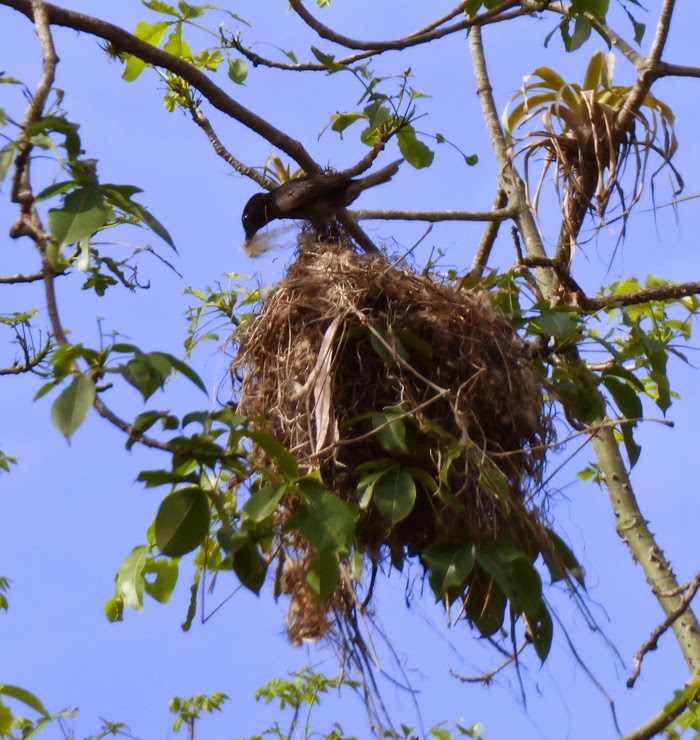We rise early for our day of exploring this gem of a reserve.
White-tailed Jay (Photos by Narca)
Along the path to the dining area, stunning White-tailed Jays are having their breakfast too, as they search out hapless moths that were attracted during the night to lights along the path. These jays live in western Ecuador and northwestern Peru, and they are very like the celebrated Tufted Jays of montane Mexico.
An impressive moth, soon to be jay food
The feeders here at Urraca Lodge have their own clientele. Handsome Guayaquil Squirrels are chowing down. This squirrel, like many of the birds, lives only in a small region of southwestern Ecuador and northwestern Peru.
Guayaquil Squirrel
A Plumbeous-backed Thrush joins the feeder birds. We'd met it earlier, in Vilcabamba.
Plumbeous-backed Thrush
A couple of fine orioles live here –– the White-edged and the more widespread Yellow-tailed. We see both, but only the Yellow-tailed cooperates for the camera.
Yellow-tailed Oriole
After breakfast, Leonidas is our guide for the day. He's very experienced, and his knowledge of the reserve and its wildlife is impressive. After a quick walk along a trail to see a calling Pale-browed Tinamou, we spend the morning walking down the reserve's road toward the highway below.
The road through Jorupe Reserve
A bounty of highly-sought-after birds makes the walk exciting. We hear, but fail to see, an Ochre-bellied Dove and a number of Watkin's Antpittas (their call sounds to me like "hey, hey, hey, whatcha doin'"). The other birds are much more cooperative, and before long, we've seen Gray-backed Hawk, Gray-cheeked Parakeet, Red-masked Parakeet, five Guayaquil Woodpeckers, Rufous-necked and Henna-hooded Foliage-gleaners, Blackish-headed Spinetail, and Slaty Becard –– all of these are considered globally vulnerable, threatened or endangered!
This male One-colored Becard, working on his monumental nest, is one of three becard species we see today
Other, less vulnerable species are quite fun too. We flush a Pauraque from her nest. I quickly photograph the egg, and when we return past the spot, she is sitting tight again.
A Pauraque's egg and nest scrape
The female Pauraque has returned to her nest
In addition to the big Guayaquil Woodpecker and the beautiful Scarlet-backed Woodpecker, little Ecuadorian Piculets are show-stealers.
The Ecuadorian Piculet, a tiny woodpecker
The Blue-crowned Motmots here sound different, and indeed they are one branch of the whole Blue-crowned Motmot complex. This superspecies is likely to be split once taxonomists have finished researching the group. If this split happens, the motmot at Jorupe will likely be called the Whooping Motmot.
A Blue-crowned Motmot (for the time being)
No day in the tropics is complete without a trogon. Here the trogon of choice is the Ecuadorian Trogon, once considered a subspecies of Black-tailed Trogon. We hear and see several of the gorgeous birds, and although they don't cooperate well for the camera, you may be able to make out the white iris in these photos.
Splendid male Ecuadorian Trogons (above and below)



















No comments:
Post a Comment